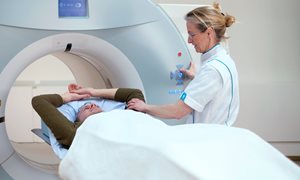
For the first time worldwide, the injection of radioactive microspheres for radiation therapy of liver tumors has been visualized live. Researchers at the Radboud University Medical Center injected the microspheres into patients with liver tumors who were lying in an MRI scanner and witnessed after each fraction whether the microspheres ended up in the tumors. The procedure appears to be safe and feasible. This enables live adjustment of the injection site and the dose in the future.
For tumors in the liver, patients are sometimes treated with radioactive microspheres injected into the hepatic artery. These microspheres get stuck in the liver in the small blood vessels that supply the tumors with blood, where they irradiate the tumors from the inside. This therapy is called radioembolization. The microspheres are injected into the blood vessel through a catheter, which a doctor places based on a scan made a week beforehand. It is only afterwards that a new scan reveals where the microspheres have ended up.
‘We sometimes see that we have not reached all tumors sufficiently. That is disappointing, because at that point the procedure is already completed and there is nothing you can do about it', says Joey Roosen, PhD student at Radboudumc. ‘We have now tried to solve this in a study in six patients by monitoring the microspheres live with an MRI scanner during the injection. We then see during the procedure on the MRI images how many microspheres end up in the tumors. This will allow us in follow-up studies to reposition the catheter to another blood vessel, or adjust the dose if necessary, directly tailored to the patient.'
Insight within 15 minutes
This is the first time worldwide that image-guided radioembolization has been performed in patients. The study shows that the procedure in the MRI scanner is feasible and safe. In addition, it shows that MRI measurements are possible during the procedure. Researcher and group leader Frank Nijsen of the Radboudumc explains: 'We inject the radioactive microspheres in four fractions. After each fraction we make an image with the MRI scanner. The recording takes three minutes and the analysis of the measurement takes ten minutes. So within fifteen minutes per fraction you have insight on the distribution of the microspheres.'
The researchers noticed during the MRI measurements that 80% of all tumors were not yet completely filled up with microspheres. 'In those tumors you would therefore want to administer more microspheres than usual, so that the treatment efficacy improves', says Roosen. 'It's a balance between filling tumors with microspheres for optimal treatment results on the one hand, and sparing the healthy liver to prevent side effects on the other. That's tailor-made work, in which the MRI can be of great assistance.'
Suitable for every hospital
The actual repositioning of the catheter and adjustment of the dose of the microspheres using the MRI scanner will take place in a follow-up study, which has also started. Nijsen: 'We have now only looked at safety and feasibility; that was the first step. In the follow-up study we will optimize the procedure for radioembolization using the MRI scanner and increase the dose. Then we want to measure what the survival gain is for patients with tumors in the liver.'
The procedure is currently still done at the Radboudumc's MITeC, where the MRI scanner is located in a modern operating room. That's because, in addition to the MRI, the researchers use X-ray to place the catheter: a week in advance for a scout scan and then again for treatment. 'Cumbersome', says Nijsen. 'We therefore want to do the entire procedure with MRI. Then a hybrid operating room is no longer required and maybe even the scan a week in advance won't be necessary anymore. We have just received a European grant for this development. Thus, we will eventually make the procedure suitable for every hospital in the world with an MRI scanner and this new technique will become available to all patients.

About the publication
This article was published in European Journal of Nuclear Medicine and Molecular Imaging: Intraprocedural MRI-based dosimetry during transarterial radioembolization of liver tumours with holmium-166 microspheres (EMERITUS-1): a phase I trial towards adaptive, image-controlled treatment delivery. Joey Roosen, Lovisa E. L. Westlund Gotby, Mark J. Arntz, Jurgen J. Fütterer, Marcel J. R. Janssen, Mark W. Konijnenberg, Meike W. M. van Wijk, Christiaan G. Overduin, J. Frank W. Nijsen.
-
Want to know more about these subjects? Click on the buttons below for more news.
More information
Annemarie Eek

wetenschapsvoorlichter






